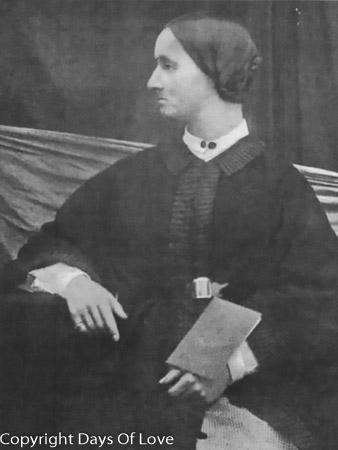 Mary
Charlotte Lloyd (January 21, 1819 – October 13, 1896) was a Welsh sculptor who studied
with John Gibson in Rome and lived for decades with feminist Frances
Power Cobbe.
Mary
Charlotte Lloyd (January 21, 1819 – October 13, 1896) was a Welsh sculptor who studied
with John Gibson in Rome and lived for decades with feminist Frances
Power Cobbe. Partner Frances Power Cobbe
Queer Places:
26 Hereford Square, Kensington, London SW7, Regno Unito
Rhagatt Hall, Carrog, Corwen LL21 9HY, Regno Unito
Tan Llan, Llanelltyd, Dolgellau LL40 2ST, Regno Unito
Tyn-y-Celyn, Llanelltyd, Dolgellau LL40 2TA, Regno Unito
St Illtud, Dolgellau LL40 2ST, Regno Unito
 Mary
Charlotte Lloyd (January 21, 1819 – October 13, 1896) was a Welsh sculptor who studied
with John Gibson in Rome and lived for decades with feminist Frances
Power Cobbe.
Mary
Charlotte Lloyd (January 21, 1819 – October 13, 1896) was a Welsh sculptor who studied
with John Gibson in Rome and lived for decades with feminist Frances
Power Cobbe.
Mary Lloyd was born in Denbighshire, Wales, the eighth of seventeen children, and the first of six girls, to Edward Lloyd of Rhagatt and his wife Frances Maddocks.[1] Her father was a substantial squire over many counties, owning 4,300 acres of land, and Mary inherited money from a maiden aunt, Margaret, as well as gifts from Eleanor Charlotte Butler and Sarah Ponsonby, the Ladies of Llangollen. Both of her parents died in 1858.
Mary studied and worked with French artist Rosa Bonheur.[2] In 1853 she was working in the studio of Welsh sculptor John Gibson in Rome, along with American sculptor Harriet Hosmer.[1]
Frances Power Cobbe made several excursions to Italy between 1857 and 1862. In Rome Cobbe met not only Harriet Hosmer but a Welsh sculptor, Mary Lloyd, who had studied and worked with Rosa Bonheur. When Cobbe, introduced by Lloyd, visited the French artist, she reported: ‘Nothing I liked about her, so much, however, as her interest in Hattie Hosmer, and her delight in hearing about her Zenobia (triumphans) in the Exhibition.’ Cobbe and Lloyd returned to London in 1862 for what was to become a thirty-year partnership. Hosmer stayed with the couple on her visits to Britain, and joined them in support of women’s enfranchisement: Hosmer, Cobbe and Lloyd were members of the London National Society for Women’s Suffrage in the late 1860s.
St Illtud, Llanelltyd
Mary met Frances Power Cobbe in the winter of 1861-2, in Rome. Mary and Frances networked with like minded women in Italy in the period, both being noncomformist, with a feminist outlook. In 1863, they settled together in London.
In 1858 Lloyd inherited a share in the Welsh landed estate of Hengwrt.[3] This allowed Lloyd to refer to herself as a landed proprietor when signing petitions supporting women's suffrage, and also gave her some local political rights, such as the ability to appoint a vicar.[1] She and Frances Power Cobbe retired to Hengwrt from London in April 1884.[4]
Mary died in 1896 from heart disease and was buried together with Frances Power Cobbe in Saint Illtud Church Cemetery, Llanelltyd.[4]
Mary and Frances were a couple, and were recognised as such by all their friends. Letters would be address to “you and Miss Lloyd” and Frances peppered her own writings with ‘our house’, ‘our garden’, ‘we’ and other joint terminology. Frances writing to her friend Mary Somerville refers to Mary as ‘my wife’ and Mary’s death in 1896 affected Frances badly. Her friend, the writer Blanche Atkinson, writing, “The sorrow of Miss Lloyd’s death changed the whole aspect of existence for Miss Cobbe. The joy of life had gone. It had been such a friendship as is rarely seen – perfect in love, sympathy, and mutual understand.” [5]
My published books: